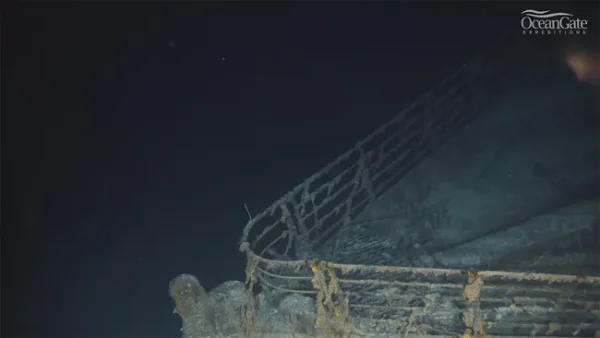Detailed features are visible in the first 8K video of the RMS Titanic’s wreckage, 110 years after it sank in the Atlantic Ocean

More than 100 years after the RMS Titanic sank, even the most diehard history buffs are seeing the ship through a whole new lens.
On Tuesday, OceanGate Expeditions released “the very first 8K video” showing some of the ship’s specific characteristics from its wreckage in the Atlantic Ocean, taken during the group’s expedition this year.
The 60-second clip, set to soft music, takes viewers on a tour of the outside of the famously doomed ship, unveiling details never seen before along the deck and areas like the bow — the latter made especially famous in the 1997 epic film Titanic.
In a press release, OceanGate Expeditions Titanic expert and longtime Titanic diver Rory Golden pointed out elements he’d never previously noticed: “For example, I had never seen the name of the anchor maker, Noah Hingley & Sons Ltd., on the portside anchor.”
“I’ve been studying the wreck for decades and have completed multiple dives, and I can’t recall seeing any other image showing this level of detail,” Golden added. “It is exciting that, after so many years, we may have discovered a new detail that wasn’t as obvious with previous generations of camera technologies.”
The release explains that, in the video, you can see the ship’s “renowned bow, the portside anchor, hull number one, an enormous anchor chain (each link weighs approximately 200 pounds or nearly 91 kilograms), the number one cargo hold, and solid bronze capstans.”
“Also captured is dramatic evidence of decay where some of the Titanic’s rail has collapsed and fallen away from the ship,” it shares.
According to OceanGate Expeditions, the new high-def footage will be used to monitor the rate of decay for future comparisons over the years.
“With the help of scientists, the video will also support identification of species that are observed on and around the Titanic and archaeologists will be able to document elements of the wreck and debris field in greater detail,” they say.
The RMS Titanic famously sank off the coast of Newfoundland in the early hours of April 15, 1912, after hitting an iceberg on its maiden voyage from Southampton, England, to New York City. The luxury passenger ship, touted as unsinkable, was famous from its inception, known as the largest and one of the most lavish of its kind at the time.
But what captured the public’s attention was that night’s human tragedy. Titanic set sail carrying some 2,200 people — millionaires, immigrants, 13 honeymooning couples, and an eight-man band that played to the bitter end — and lifeboats for just over half of them. In the end, 712 people were rescued; the rest drowned or froze in the water.
“It was the biggest ship in history, filled with celebrities of that time,” said James Cameron — director of the blockbuster Titanic, which became the first film to gross more than $1 billion worldwide, was nominated for a record-tying 14 Oscars and propelled actors Leonardo DiCaprio and Kate Winslet into the rarefied realm of superstardom — amid the wreck’s 110th anniversary in April.
“It would be like if you took a jumbo jet filled with half the stars in Hollywood and crashed it into the Washington Monument,” added Cameron, 68.
[via]






